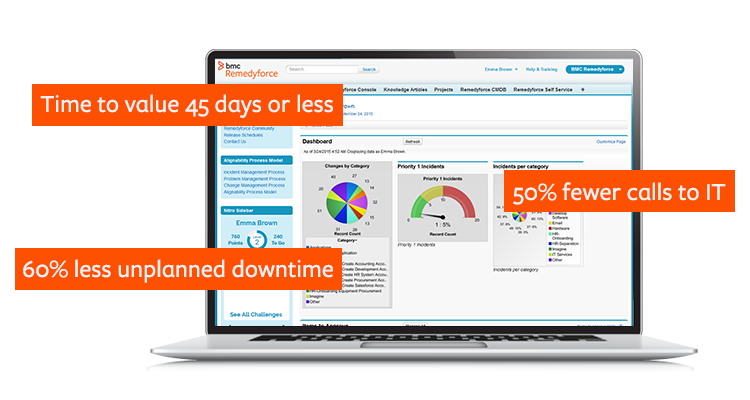In this Run and Reinvent podcast, I chat with Simon Eldon, Head of Support at Euromonitor International about how BMC Helix Remedyforce has transformed the company’s IT Service Management (ITSM). Below is a condensed transcript of our conversation.
John Fulton: Tell us a little bit about Euromonitor, what they do, and how you support them.

Simon Eldon: Euromonitor’s business is really all about providing market intelligence to our clients. The value that we add is to help and support them in making decisions about their own business operations. Various platforms enable our customers to access syndicated market research and analysis on different industries, economies, countries, and consumer markets across the world.
We also have a really strong consulting team that can answer specific bespoke questions for clients. We’re a pretty broad base for a lot of different types of business operations [like] manufacturing, banks, academic institutions, and agencies. People primarily come to us as a proxy for their own market research function. They can get that content and analysis and insight when they need it and not have to pay for it 12 months a year.
John: You’re are a global company [that’s] continually growing in terms of getting not only reporting in different markets and regions, but also an internal employee perspective.
Simon: We have expanded our physical presence and we’re now 15 offices [and] we have quite a lot of people that work for us on a freelance basis. We probably have Euromonitor representatives in at least 100 countries by now.
John: When I hear 100 countries, I can imagine that the more dispersed you are, the more challenges you are facing as you’re growing.
Simon: The challenges are quite complex. Given that that we are focused on adding value to our clients through up-to-date insight and information, there’s a clear challenge to be relevant, leading those conversations, and offer clients up-to-date, quick information around the topics of the day.
As we expand geographically, we have to support more people, and more colleagues as they come online. And we have to offer them the same service that we do in other offices. [We] really strive to provide a high-quality support service across the organization and [to] our customers.
John: [Talk about your] challenges of timeliness that put added pressure on your organization and the IT group to support both your customers and maintain [your] systems.
Simon: That definitely pulls us in two directions. We need to answer people’s questions and solve [their] problems, but we also have to deliver quality service. And that also means being able to transform our own technology to take advantage of some of the more scalable and easily managed capabilities, like the cloud.
Euromonitor has been around [since] 1973.There’s been a revolution in the way that we deliver service, first [with] on-premise delivery of digital systems, which has now migrated…to cloud capabilities and taking advantage of scalability around all of that.
As a support service delivery unit, we have to be aligned. We have to understand that [and] answer questions that people have about the technology and how they get the most out of it. So [there’s a] customer service element [and we] have to be up to speed on all the tech changes, too. And that’s what makes a job interesting.
John: [In terms of] digital transformation, can you characterize some of those key business challenges that you’re facing today?
Simon: Customer expectations are number one. Customers expect so much more now in terms of speed of response. And that’s not just about…systems. It’s also about speed of response as an organization to their changing needs. We’ve definitely seen that increase over the last few years.
That’s changed our relationship with clients [and the] way that we work with people. I think what we’re seeing is a gradual evolution from a client-customer-provider relationship, toward a partnership relationship with a lot more people because it’s the only way that we can practically deliver what we need to deliver to people.
John: [Talk about] your role as head of support and service delivery.
Simon: I look after a team of 30 people globally. [There are] two main strands: traditional tech support, which is the desktop services, and all those kinds of things; and the business application side of things and our product support. We have a need internally for our colleagues to be able to understand and use all of our products efficiently and effectively so they can be good at sales and research and whatever their role is within the business. We provide that internal support. We also provide external support to our clients…for issues with the system [or] logging in. We’re very much trying to focus also on a new idea of continual service improvement.
John: What challenges, pain points, and business goals prompted you to look for an ITSM solution prior to selecting Remedyforce?
Simon: When I first joined the business in the support team, there were two of us. As the business changed, we grew. We made a decision to develop something to help us to support that increasing support workload [so] resources could be used for more effective business and value-add elsewhere. Around that time, we were talking about adopting more industry-standard practices so that we could align ourselves with some of the fundamentals of ITIL® and all that’s within that framework.
John: What were the challenges or pain points that were impacting that decision?
Simon: The delay. Incidents might sit in a queue for a while. There was very little way of differentiating between staff and clients. And it wasn’t so easy to report on stuff and track things, so the visibility of the work was not great. And it just wasn’t efficient. We had no way of planning the service improvements and changes around processes without a lot of time, cost, and investment.
John: What were your key criteria for why you chose BMC Helix Remedyforce?
Simon: We wanted something that was fit for purpose, but not overblown. Our requirements were not enterprise-level at the time, but we wanted something that would be flexible enough to meet our changing needs. Three [to] three and a half years ago, it was obvious that we were coming up to a point where a lot of things were going to change. We wanted to have a system that would meet the requirements of that time, but also adapt with us and be reasonably future-proof.
One of the key decision elements around Remedyforce was the fact that it is integrated with Salesforce. We’d had Salesforce in the business for around a year at that point. As an existing Salesforce customer, it really helps with integration of the new system into the business around being able to demonstrate back to sales which of their clients had logged tickets and things like that, or just easy wins.
Everybody in the business has a Salesforce account of some kind, and it just made sense. It also meant that we didn’t have to buy into any on-premise infrastructure to maintain anything. For us, there was a zero gain of responsibility in terms of that maintenance.
Remedyforce [also aligns] with ITIL® processes and the ability to look at what we wanted to do as a service improvement project. I like the flexibility of it, too. The fact that we’ve been able to start with the incident management planning, and work on improving that, and then look at service requests, and then move on to something else.
I’ve got confidence that I know Remedyforce can accommodate all of this stuff and help us to improve things without having to go back to the board and [ask for more investment]. That flexibility and the scalability is really key as far as getting value out of the system.
We can [also] talk to the Customer Success Team at BMC and get some really good added value out of that with recommendations and advice. That relationship has been [a] good foundation for being able to go through this journey. I never wanted to be stuck with a system where [for] every single change, I had to call a consultant and pay him $1,000 a day to change two labels.
John: You mentioned incident service requests. Is there anything beyond that, that you’re currently using or planning to use in the future?
Simon: Incident service goes to the heart of what we do. One of the big benefits that we’ve taken advantage of is putting [product] incidents from clients directly into the service desk queue. We use a mail relay to do that and that works well for us.
John: So, you’re managing both your internal customers and your external clients within Remedyforce.
Simon: Absolutely. On our product pages, we have a technical support link and they can click on that, fill out their information, and behind the scenes, it will send an e-mail in and that will get logged as a ticket onto the system. It gives us visibility quickly of what clients want. That’s been a great benefit for us.
Other business functions use the system as well. We do most of the work on the system, but HR service requests get logged on Remedyforce, and the finance team uses it. They can log those tickets and deal with that directly. We never see them. It’s something that I think we’re likely to scale out in the future.
John: You’ve been using Remedyforce for three and a half years. What have been the outcomes?
Simon: The key benefit has really been about the manageability and visibility. There’s a real challenge for us as a team in terms of being able to service information in a timely way when we’re spread out geographically from Chicago to Shanghai.
The ability for us to update notes and pass information between team members [in different regions] has been hugely beneficial, so that [the] status of everything is visible to everyone at all times. And wherever you log on, you can see what’s gone on and what needs to happen next and so the management of that is easier. Internally, it’s been hugely beneficial to the team and has provided benefit back to our colleagues so they can get a more consistent and reliable service from us. [We’ve] been able to deal with clients much more effectively.
From a management perspective, [having] all of this stuff in one place [helps me] put together reports and go back to my boss and have conversations about resource requirements and workloads. From the bottom to the top, is it’s been beneficial.
John: This podcast is called the Run and Reinvent Podcast. Can you highlight or comment on how Remedyforce has allowed you to shift your focus from less running to more reinventing?
Simon: It’s really provided us with that baseline where we can now deal with the day-to-day much more reliably and easily and spend more time on things which are more helpful [and] have the resources to focus on those high-value projects…because we’ve got Remedyforce in place. That allows us really to concentrate on the improvement efforts.
John: What do you see as the next steps in terms of where you’re headed with [the] solution?
Simon: We are looking to improve our operational processes and change management. I want to look at our problem management process. We need to realign that with some of the other processes that are going on with technology at the moment. We’re looking at reviewing our KPIs for team members, and Remedyforce will be able to help us with that.
Remedyforce has enabled us to modernize our support service from what was quite a low and manual beginning. It’s allowed us to respond to a lot of organizational change in a timely manner. We’ve got a system which will scale and help us quickly. I’m really confident that it will continue to be that solution as we move forward with our journey to service management improvements. It’s been a lot of fun, as well. If it’s not fun, what’s the point?
Listen to the full episode on SoundCloud or Apple Podcasts.






